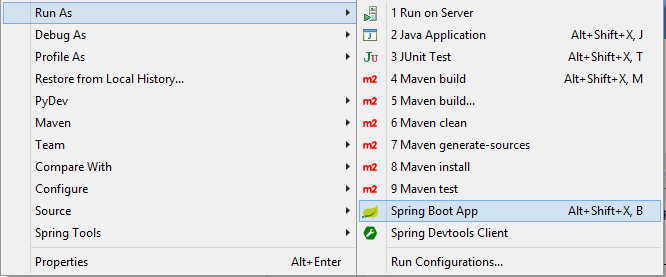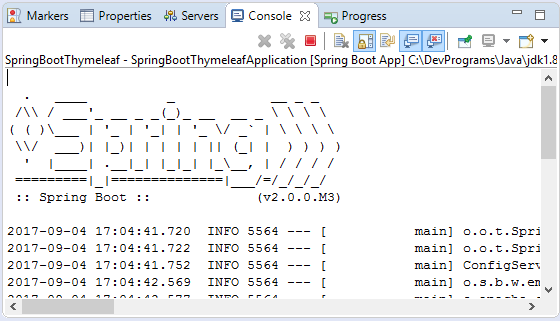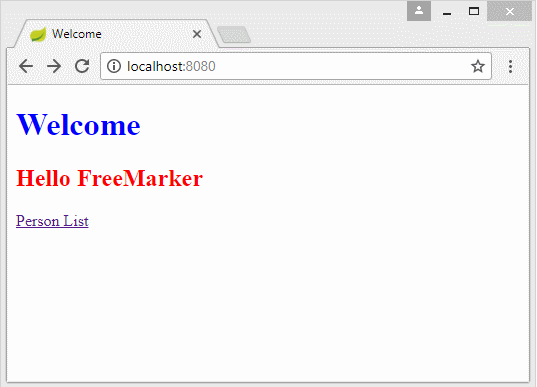Le Tutoriel de Spring Boot et FreeMarker
1. Qu'est-ce que FreeMarker ?
FreeMarker est un Template Engine (un moteur de template), il est fournit par Apache comme une bibliothèque Java source ouverte. FreeMarker lit des fichiers modèle et les combine avec des objets Java pour générer (generate) un texte de sortie (Html, email, ..).
Les fichiers modèle (Template file) của FreeMarker est par essence un fichier texte dans le format introduit par le FreeMarker, c'est FreeMarker Template Language (FTL).
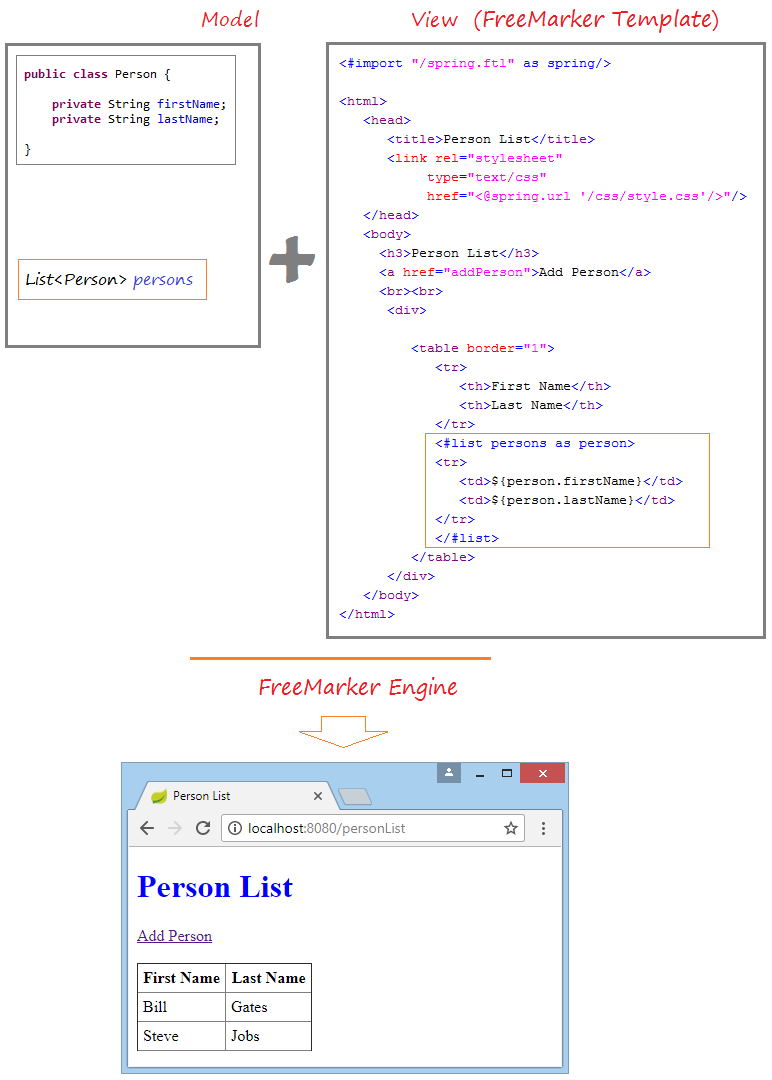
FreeMarker peut être utilisé à remplacer JSP sur View (View Layer) de l'application Web MVC.
Ci-dessous est l'image de l'application que nous effectuons dans cette leçon :
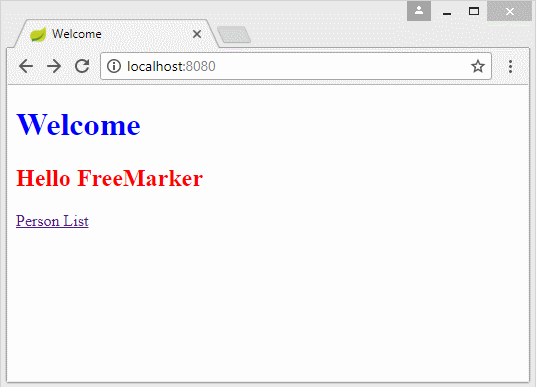
2. Créer une application
Sur Eclipse sélectionnez :
- File/New/Other...
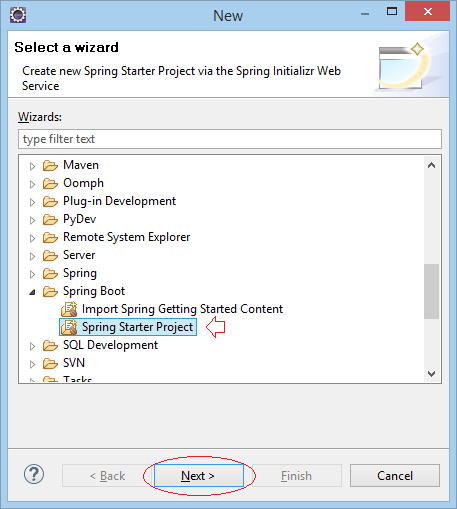
Saisissez :
- Name: SpringBootFreeMarker
- Group: org.o7planning
- Artifact: SpringBootFreeMarker
- Description: Spring Boot and FreeMarker
- Package: org.o7planning.freemarker
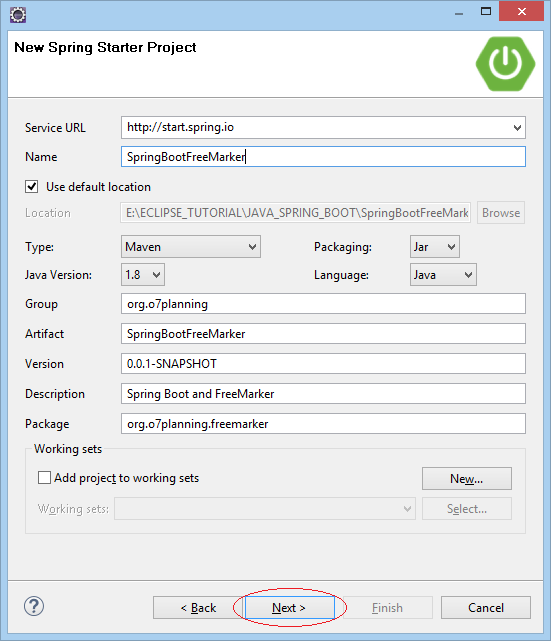
Sélectionnez 2 technologies Web et FreeMarker.
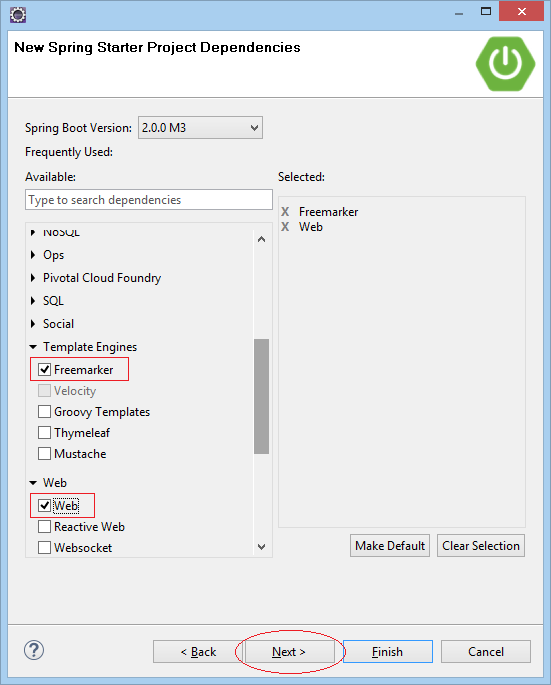
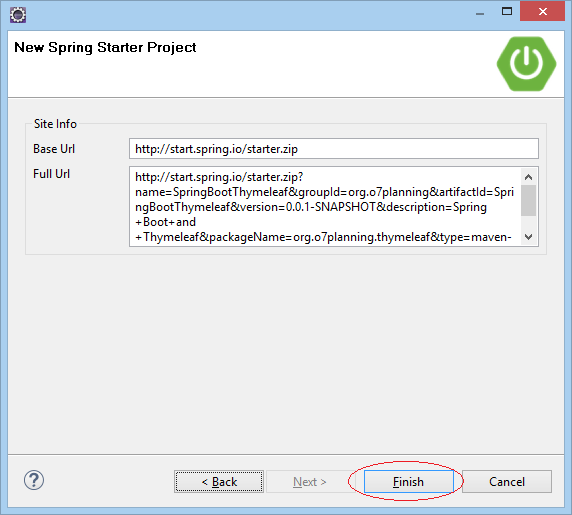
Votre projet a été créé :
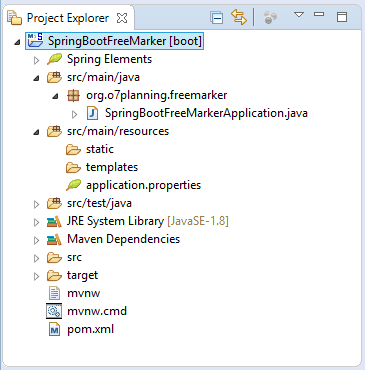
pom.xml
<?xml version="1.0" encoding="UTF-8"?>
<project xmlns="http://maven.apache.org/POM/4.0.0" xmlns:xsi="http://www.w3.org/2001/XMLSchema-instance"
xsi:schemaLocation="http://maven.apache.org/POM/4.0.0 http://maven.apache.org/xsd/maven-4.0.0.xsd">
<modelVersion>4.0.0</modelVersion>
<groupId>org.o7planning</groupId>
<artifactId>SpringBootFreeMarker</artifactId>
<version>0.0.1-SNAPSHOT</version>
<packaging>jar</packaging>
<name>SpringBootFreeMarker</name>
<description>Spring Boot and FreeMarker</description>
<parent>
<groupId>org.springframework.boot</groupId>
<artifactId>spring-boot-starter-parent</artifactId>
<version>2.0.0.RELEASE</version>
<relativePath/> <!-- lookup parent from repository -->
</parent>
<properties>
<project.build.sourceEncoding>UTF-8</project.build.sourceEncoding>
<project.reporting.outputEncoding>UTF-8</project.reporting.outputEncoding>
<java.version>1.8</java.version>
</properties>
<dependencies>
<dependency>
<groupId>org.springframework.boot</groupId>
<artifactId>spring-boot-starter-freemarker</artifactId>
</dependency>
<dependency>
<groupId>org.springframework.boot</groupId>
<artifactId>spring-boot-starter-web</artifactId>
</dependency>
<dependency>
<groupId>org.springframework.boot</groupId>
<artifactId>spring-boot-starter-test</artifactId>
<scope>test</scope>
</dependency>
</dependencies>
<build>
<plugins>
<plugin>
<groupId>org.springframework.boot</groupId>
<artifactId>spring-boot-maven-plugin</artifactId>
</plugin>
</plugins>
</build>
</project>3. FreeMarker Template
Nous allons créer 3 fichier modèle (Template file) et les mettre dans le répertoire src/main/resources/templates:
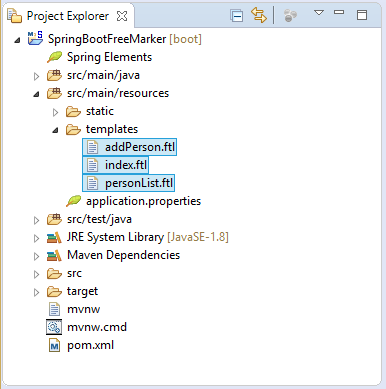
index.flt
<#import "/spring.ftl" as spring/>
<!DOCTYPE HTML>
<html>
<head>
<meta charset="UTF-8" />
<title>Welcome</title>
<link rel="stylesheet"
type="text/css" href="<@spring.url '/css/style.css'/>"/>
</head>
<body>
<h1>Welcome</h1>
<#if message??>
<h2>${message}</h2>
</#if>
<a href="<@spring.url '/personList'/>">Person List</a>
</body>
</html>personList.flt
<#import "/spring.ftl" as spring/>
<html>
<head>
<title>Person List</title>
<link rel="stylesheet"
type="text/css"
href="<@spring.url '/css/style.css'/>"/>
</head>
<body>
<h3>Person List</h3>
<a href="addPerson">Add Person</a>
<br><br>
<div>
<table border="1">
<tr>
<th>First Name</th>
<th>Last Name</th>
</tr>
<#list persons as person>
<tr>
<td>${person.firstName}</td>
<td>${person.lastName}</td>
</tr>
</#list>
</table>
</div>
</body>
</html>addPerson.flt
<#import "/spring.ftl" as spring/>
<html>
<head>
<title>Add Person</title>
<link rel="stylesheet"
type="text/css" href="<@spring.url '/css/style.css'/>"/>
</head>
<body>
<#if errorMessage??>
<div style="color:red;font-style:italic;">
${errorMessage}
</div>
</#if>
<div>
<fieldset>
<legend>Add Person</legend>
<form name="person" action="" method="POST">
First Name: <@spring.formInput "personForm.firstName" "" "text"/> <br/>
Last Name: <@spring.formInput "personForm.lastName" "" "text"/> <br/>
<input type="submit" value="Create" />
</form>
</fieldset>
</div>
</body>
</html>Tous les fichiers modèle devraient déclarer un "FreeMarker Macros".
<!-- FreeMarker Macros -->
<#import "/spring.ftl" as spring/>Dans les fichiers modèle (Template file)il y a des Thymeleaf Marker (Des marqueurs de Thymeleaf), qui sont des instructions assistant le Thymeleaf Engine à procéder des données.
Thymeleaf Engine analyse le fichier modèle (Template file), et combine des données Java afin de gérer (generate) un nouveau document.
Thymeleaf Engine analyse le fichier modèle (Template file), et combine des données Java afin de gérer (generate) un nouveau document.
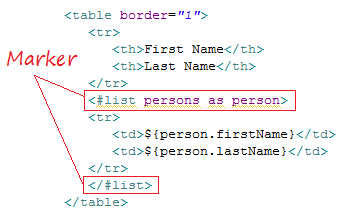
Ci-dessous sont des exemples à utiliser Context-Path dans FreeMarker:<!-- Example 1: --> <a href="<@spring.url '/mypath/abc.html'/>">A Link</a> Output: ==> <a href="/my-context-path/mypath/abc.html">A Link</a> <!-- Example 2: --> <form action="<@spring.url '/mypath/abc.html'/>" method="POST"> Output: ==> <form action="/my-context-path/mypath/abc.html" method="POST">
4. Static Resource & Properties File
Pour les ressources statiques (Static Resource), par exemple : des fichiers css, javascript, image,.. vous devriez les mettre dans le répertoire src/main/resources/static ou dans ses sous - répertoires.
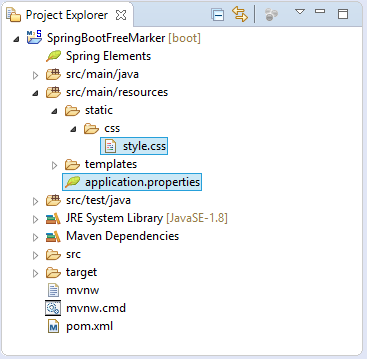
style.css
h1 {
color:#0000FF;
}
h2 {
color:#FF0000;
}
table {
border-collapse: collapse;
}
table th, table td {
padding: 5px;
}application.properties
welcome.message=Hello FreeMarker
error.message=First Name & Last Name is required!5. Des classes Model, Form, Controller
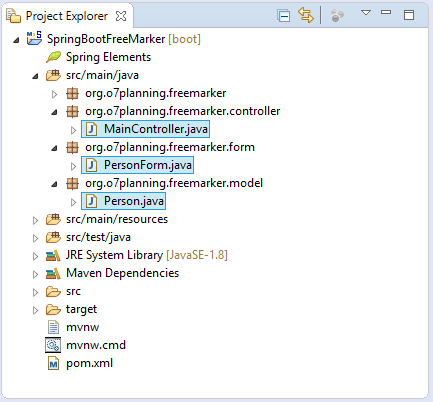
Person.java
package org.o7planning.freemarker.model;
public class Person {
private String firstName;
private String lastName;
public Person() {
}
public Person(String firstName, String lastName) {
this.firstName = firstName;
this.lastName = lastName;
}
public String getFirstName() {
return firstName;
}
public void setFirstName(String firstName) {
this.firstName = firstName;
}
public String getLastName() {
return lastName;
}
public void setLastName(String lastName) {
this.lastName = lastName;
}
}La classe PersonForm représente des données du FORM que vous crée une nouvelle Person sur la page addPerson.
PersonForm.java
package org.o7planning.freemarker.form;
public class PersonForm {
private String firstName;
private String lastName;
public String getFirstName() {
return firstName;
}
public void setFirstName(String firstName) {
this.firstName = firstName;
}
public String getLastName() {
return lastName;
}
public void setLastName(String lastName) {
this.lastName = lastName;
}
}MainController est une classe Controller, qui procède les demandes de l'utilisateurs et controle un flux (flow) d'application.
MainController.java
package org.o7planning.freemarker.controller;
import java.util.ArrayList;
import java.util.List;
import org.o7planning.freemarker.form.PersonForm;
import org.o7planning.freemarker.model.Person;
import org.springframework.beans.factory.annotation.Value;
import org.springframework.stereotype.Controller;
import org.springframework.ui.Model;
import org.springframework.web.bind.annotation.ModelAttribute;
import org.springframework.web.bind.annotation.RequestMapping;
import org.springframework.web.bind.annotation.RequestMethod;
@Controller
public class MainController {
private static List<Person> persons = new ArrayList<Person>();
static {
persons.add(new Person("Bill", "Gates"));
persons.add(new Person("Steve", "Jobs"));
}
// Injectez (inject) de l'application.properties.
@Value("${welcome.message}")
private String message;
@Value("${error.message}")
private String errorMessage;
@RequestMapping(value = { "/", "/index" }, method = RequestMethod.GET)
public String index(Model model) {
model.addAttribute("message", message);
return "index";
}
@RequestMapping(value = { "/personList" }, method = RequestMethod.GET)
public String personList(Model model) {
model.addAttribute("persons", persons);
return "personList";
}
@RequestMapping(value = { "/addPerson" }, method = RequestMethod.GET)
public String addPersonForm(Model model) {
PersonForm personForm = new PersonForm();
model.addAttribute("personForm", personForm);
return "addPerson";
}
@RequestMapping(value = { "/addPerson" }, method = RequestMethod.POST)
public String addPersonSave(Model model, //
@ModelAttribute("personForm") PersonForm personForm) {
String firstName = personForm.getFirstName();
String lastName = personForm.getLastName();
if (firstName != null && firstName.length() > 0 //
&& lastName != null && lastName.length() > 0) {
Person newPerson = new Person(firstName, lastName);
persons.add(newPerson);
return "redirect:/personList";
}
String error = "First Name & Last Name is required!";
model.addAttribute("errorMessage", error);
return "addPerson";
}
}Tutoriels Spring Boot
- Installer Spring Tool Suite pour Eclipse
- Le Tutoriel de Spring pour débutant
- Le Tutoriel de Spring Boot pour débutant
- Propriétés communes de Spring Boot
- Le Tutoriel de Spring Boot et Thymeleaf
- Le Tutoriel de Spring Boot et FreeMarker
- Le Tutoriel de Spring Boot et Groovy
- Le Tutoriel de Spring Boot et Mustache
- Le Tutoriel de Spring Boot et JSP
- Le Tutoriel de Spring Boot, Apache Tiles, JSP
- Utiliser Logging dans Spring Boot
- Surveillance des applications avec Spring Boot Actuator
- Créer une application Web multilingue avec Spring Boot
- Utiliser plusieurs ViewResolvers dans Spring Boot
- Utiliser Twitter Bootstrap dans Spring Boot
- Le Tutoriel de Spring Boot Interceptor
- Le Tutoriel de Spring Boot, Spring JDBC et Spring Transaction
- Le Tutoriel de Spring JDBC
- Le Tutoriel de Spring Boot, JPA et Spring Transaction
- Le Tutoriel de Spring Boot et Spring Data JPA
- Le Tutoriel de Spring Boot, Hibernate et Spring Transaction
- Intégration de Spring Spring, JPA et H2 Database
- Le Tutoriel de Spring Boot et MongoDB
- Utiliser plusieurs DataSources avec Spring Boot et JPA
- Utiliser plusieurs DataSources avec Spring Boot et RoutingDataSource
- Créer une application de connexion avec Spring Boot, Spring Security, Spring JDBC
- Créer une application de connexion avec Spring Boot, Spring Security, JPA
- Créer une application d'enregistrement d'utilisateur avec Spring Boot, Spring Form Validation
- Exemple de OAuth2 Social Login dans Spring Boot
- Exécuter des tâches planifiées en arrière-plan dans Spring
- Exemple CRUD Restful WebService avec Spring Boot
- Exemple Spring Boot Restful Client avec RestTemplate
- Exemple CRUD avec Spring Boot, REST et AngularJS
- Sécurité Spring RESTful Service utilisant Basic Authentication
- Sécuriser Spring Boot RESTful Service en utilisant Auth0 JWT
- Exemple Upload file avec Spring Boot
- Le exemple de Download file avec Spring Boot
- Le exemple de Upload file avec Spring Boot et jQuery Ajax
- Le exemple de Upload file avec Spring Boot et AngularJS
- Créer une application Web Panier avec Spring Boot, Hibernate
- Le Tutoriel de Spring Email
- Créer une application Chat simple avec Spring Boot et Websocket
- Déployer le application Spring Boot sur Tomcat Server
- Déployer le application Spring Boot sur Oracle WebLogic Server
- Installer un certificat SSL gratuit Let's Encrypt pour Spring Boot
- Configurer Spring Boot pour rediriger HTTP vers HTTPS
Show More
